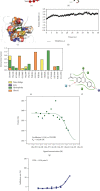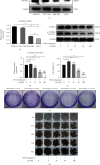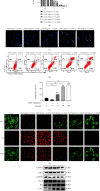Licoflavone A Suppresses Gastric Cancer Growth and Metastasis by Blocking the VEGFR-2 Signaling Pathway
- PMID: 35509849
- PMCID: PMC9061026
- DOI: 10.1155/2022/5497991
Licoflavone A Suppresses Gastric Cancer Growth and Metastasis by Blocking the VEGFR-2 Signaling Pathway
Abstract
Objectives: Licoflavone A (LA) is a natural flavonoid compound derived from the root of Glycyrrhiza. This study investigated the antitumor effect and underlying molecular mechanisms of LA against gastric cancer (GC) in vitro and in vivo.
Materials and methods: A CCK8 assay was used to measure the antiproliferative activity of LA in human GC SGC-7901, MKN-45, MGC-803 cells, and human GES-1 cells. Target prediction and protein-protein interaction (PPI) analysis were used to identify the potential molecular targets of LA. The binding pattern of LA to VEGFR-2 was analyzed by molecular docking and molecular dynamic (MD). The affinity of LA for VEGFR-2 was determined by microscale thermophoresis (MST). The protein tyrosine kinase activity of VEGFR-2 in the presence of LA was determined by an enzyme activity test. The effect of LA on the proliferation of VEGF-stimulated MKN-45 cells was measured with CCK8 assays, clone formation assays, and 3D microsphere models. Hoechst 33342 staining, FCM, MMP, and WB assays were used to investigate the ability of LA to block cell cycle and promote apoptosis of VEGF-stimulated MKN-45 cells. Transwell matrix assays were used to measure migration and invasion, and WB assays were used to measure EMT.
Results: LA inhibited the proliferation of SGC-7901, MKN-45, and MGC-803 cells and VEGF-stimulated MKN-45 cells. VEGFR-2 was identified as the target of LA. LA could also block cell cycle, induce apoptosis, and inhibit migration, invasion, and EMT of VEGF-stimulated MKN-45 cells. Functional analyses further revealed that the cytotoxic effect of LA on VEGF-stimulated MKN-45 cells potentially involved the PI3K/AKT and MEK/ERK signaling pathways.
Conclusions: This study demonstrates that LA has anti-GC potency in vitro and in vivo. LA affects the proliferation, cycle, apoptosis, migration, invasion, and EMT by targeting VEGFR-2 and blocks the PI3K/AKT and MEK/ERK signaling pathways in VEGF-stimulated MKN-45 cells.
Copyright © 2022 Gong Hongxia et al.
Conflict of interest statement
The authors declare that there is no conflict of interest regarding the publication of this paper.
Figures








References
-
- Latest global cancer data: cancer burden rises to 19.3 million new cases and 10.0 million cancer deaths in 2020. https://www.iarc.fr/fr/news-events/latest-global-cancer-data-cancer-burd...
-
- Jie G. A., Km A., Lei Z. B., Lokeshwar B. Spice up your food for cancer prevention: cancer chemo-prevention by natural compounds from common dietary spices. Evolutionary Diversity as a Source for Anticancer Molecules . 2021:275–308. doi: 10.1016/B978-0-12-821710-8.00013-8. - DOI
LinkOut - more resources
Full Text Sources
Miscellaneous

